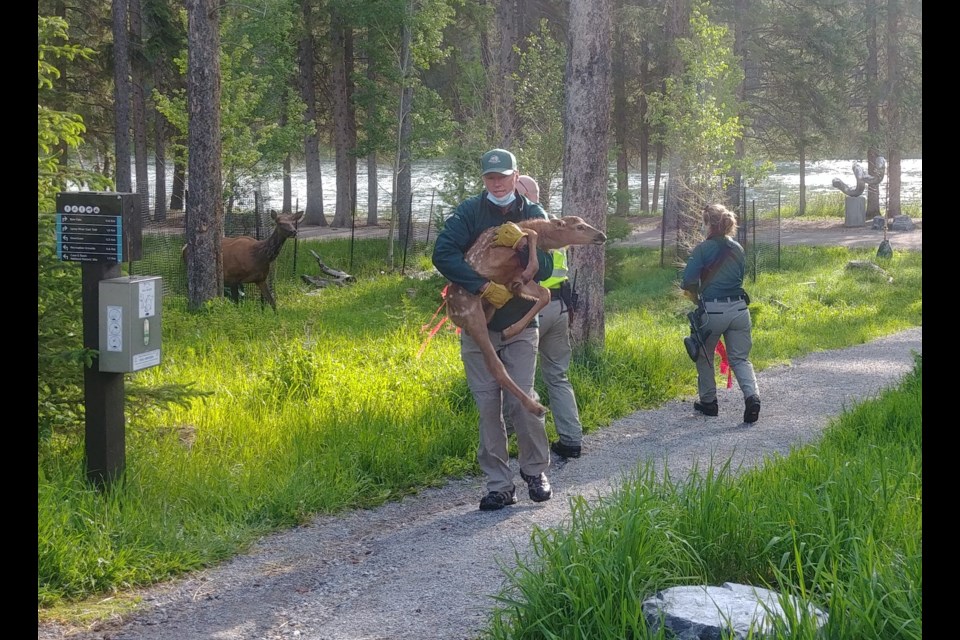BANFF – Cow elk protecting their defenceless newborn calves are leading to several aggressive incidents with people in and around the Banff townsite.
Parks Canada wildlife experts say elk should not be mistaken for tame animals just because they’re in town, on the golf course, on trails or playing fields, noting mother elk will aggressively protect their newborns by charging or striking with sharp hooves.
Blair Fyten, a human-wildlife coexistence specialist with Banff National Park, said elk typically use areas closer to town as a refuge to avoid predators during calving season, which runs from mid May to early July.
“People don’t realize there’s a calf hidden on the ground and all of a sudden they’ve got a female elk charging at them,” he said, noting there have been 11 aggressive incidents over the past three weeks.
“None of them have been contact charges this year so far, thank God, but the female comes flying in pretty quick with ears laid back and grinding her teeth, and then you realize there’s probably a calf hidden on the ground close by.”
The majority of cow elk are bred in September and into October, and after an approximately 245-day gestation period, cows will separate from the rest of the herd in spring to give birth.
A newborn calf can stand within 30 minutes to an hour of birth, but remains defenceless against predators for the first few weeks of its life, so cow elk keep the newborns well hidden in bushes and shrubs.
The mother elk visits her newborn to nurse a few times a day, but always stands guard not too far away. She licks her calf all over to make sure it is perfectly clean and clear of any smells that could attract predators like wolves or cougars.
Not only does the lack of smell from licking and the spotted coat keep them well camouflaged from predators, but Fyten said it also makes the calves difficult for people to see before it’s too late.
“If you do see a lone female, it’s probably a good indication that she’s got a calf nearby,” he said.
“They’re a herd animal, and generally once calves get a little bit more mobile, they form up into their nursery herds.”
So far this calving season, wildlife experts have had to remove at least eight elk calves born in busy human use areas or in people’s backyards – in areas such as The Banff Centre and in the Middle Springs and Spray Avenue neighbourhoods.
“We’ve had to do several scoop-and-runs, where we pick up calves that were born in yards or green areas within the townsite,” Fyten said.
“We’ve had to relocate those calves and put them in a better spot.”
Fyten said the elk tend to give birth closer to town to avoid predators such as cougars and wolves.
He said the Bow Valley wolf pack has become more comfortable hunting fairly close to town over the past few years, noting the pack had several successful kills in the Tunnel Mountain area this past winter.
“They are working the edge of town fairly closely and the reason is that’s where the elk are,” Fyten said.
“That also pushes the elk into town a little further seeking that safety, so when cows go to have their calves, they try to find an area where there’s going to be less carnivores.”
The west slope of Tunnel Mountain, which is an important calving ground for elk due to low levels of human use, remains off limits to people until June 30 to give mother elk and their calves space and security.
All official trails in the surrounding area, Tunnel Mountain Trail, Surprise Corner and the Bow River Trail, remain open.
“That closure provides us a good place to put calves when we do the scoop-and-runs from The Banff Centre,” Fyten said. “We’ve moved a few calves from The Banff Centre and gone across Tunnel Mountain Drive and placed them in that closure.”
To avoid an elk encounter, Parks Canada advises people to stay at least 30 metres away from all elk, walk on roads rather than forested trails at this time of year, keep children within arm’s reach and always keep dogs on a leash.
They also recommend people travel in groups, make lots of noise, and carry a walking stick or umbrella.
“If an elk does charge at you, you have something to help defend yourself with,” Fyten said.
Bear spray is also recommended to thwart a potential elk attack.
“We have noticed that bear spray does work on elk,” Fyten said. “We’ve used it a few times ourselves to push back an aggressive elk.”
If someone can’t avoid an attack, Parks Canada recommends acting dominant by raising your arms or flapping your jacket to make yourself appear bigger; maintaining eye contact and moving away; and deploying bear spray if feasible.
“If you do find yourself getting knocked to the ground, don’t play dead,” Fyten said.
“Roll away, do whatever you can to get behind a tree or vehicle or into your house, but never play dead in this situation.”
All aggressive elk encounters should be reported to Banff dispatch at 403-762-1470.



